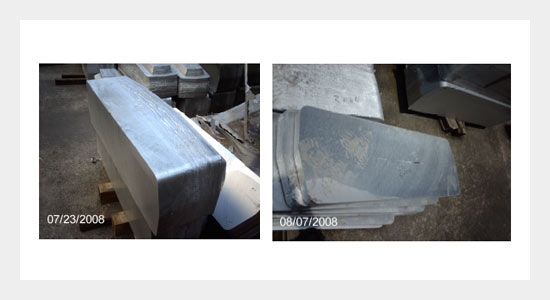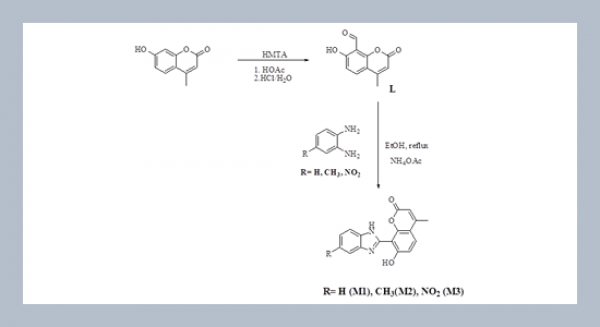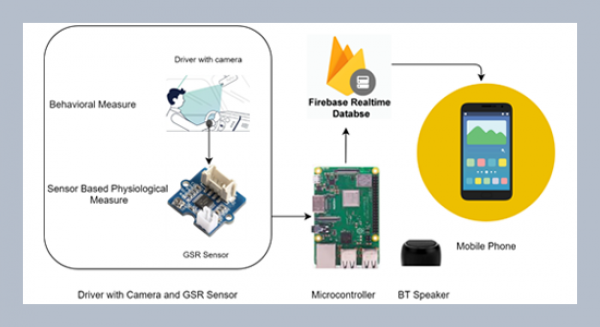Kun-Nan Lie*, Yen-Hsun Chen, and Meng-Tsun Tsai Far East University Tainan, Taiwan, R.O.C.
Download Citation:
|
Download PDF
A direct-chill (DC) cast process of an aluminum ingot of size 3200×1292×320 mm3 is analyzed numerically by the analysis of a fixed controlled system. The study investigates the DC processes in which liquid aluminum is cooling continuously in mold and then with water spray at the exit of mold. An inverse method is applied to measure heat transfer coefficient on water cooling surface experimentally. A correlation of heat transfer coefficient with surface temperature is used in numerical simulation. It has been approved that the defected curl and tears are caused by the higher rates of initial cooling and solidifying in mold and the sweat and liquation are caused by the isolation of heat transfer by air gap formed between cast solid surface and the mold wall by volume shrinkage with solidification. The present research analyzes the variations of temperature profiles in the cast ingot by the changes of cast speed and cast temperature and assesses the improvements of mold and cast process for the better cast quality. ABSTRACT
Keywords:
Aluminum casting; direct chill process; inverse method; liquid head.
Share this article with your colleagues
[1] Drezet, J. M., Rappaz, M. et al. 2000. Determination of Thermophysical Properties and Boundary Conditions of Ddirect-Chill Cast Aluminum Alloys Using Inverse Methods. J. Metal Mater Tran., 31B.: 1627-1634.REFERENCES
[2] Grandfield, J. F., Hoadley, A. and Instone, S. 1997. Synthesis and photophysical properties of a new cationic water-soluble Zn phthalocyanine. J. Light Metals, 691-699.
[3] Maner, L., Magnin, B. and Caratini, Y. 1997. Exsolution of magmatic volatile phases from Cl-enriched mineralizing granitic magmas and implications for ore metal transport. J. Light Metals, 701-707.
[4] Weckman, D. C. and Niessen, P. 1982. A Numerical Simulation of the DC Continuous Casting Including Nucleate Boiling Heat Transfer. J. Metal Mater Tran., 13B.: 593-602.
[5] Dag Mortensen. 1999. A Mathematical Model of the Heat and Fluid Flows in Direct-Chill Casting of Aluminum Sheet Ingots and Billets. J. Metal Mater Tran., 30B.: 119-133.
[6] Drezet, J. M., Burghardt, A., Fjaer, H. G. and Mabnin, B. 2000. Thermomechanical Effects in DC Casting of Aluminium Alloy: a Numerical Benchmark Study. Materials Science Forum, 329-330: 493.
[7] Drezet, J. M., Rappaz M. and Huglen R. 1997. Direct Chill Casting of Aluminum Alloys : Ingot Distorsion and Mold Design Optimization. J. Light Metals, 491.
[8] Prasso, D. C., Evans, J. W. and Wilson, I. 1995. Heat transport and solidification in the electromagnetic casting of aluminum alloys: Part II. Development of a mathematical model and comparison with experimental results. J. Metal Mater Trans., 26B: 1281
[9] Xie, C. L. 2005. “Theoretical and Experimental Study of the Multi-Strand Low-Frequency Electromagnetic Casting of Aluminum Alloy”. Master Dissertation, Inner Mongolia University of Science and Technology, China.
[10] Dua, Q., Eskina, D. G., and Katgermanb, L. 2005. The Effect of Ramping Casting Speed and Casting Temperature on Temperature Distribution and Melt Flow Patterns in the Sump of DC Cast Billet. Material Science and Engineering, 413-414: 144-150.
[11] Lalpoor, M., ESkin, D. G., Ruvalcaba, D., Fjar, H. G., Ten Cate, A., Ontijt, N., and Katgerman, L. 2011. Cold Cracking in DC-Cast High Strength Aluminum Alloy Ingot: An Intrinsic Problem Intensified by Casting Process Parameters. Material Science and Engineering, 528-6: 2831-2842.
[12] Adrian Sabau, Kazumori Kuwana Sabau, A., K., Viswanathan, S., Saito, K., and Daris, L. 2004. Heat Transfer Boundary Conditions for the Numerical Simulation of the DC Casting Process in Proceedings of Light Metals. J. Light Metals, 667-672.
ARTICLE INFORMATION
Received:
2013-07-25
Revised:
2014-06-24
Accepted:
2014-07-08
Available Online:
2014-12-01
Lie, K.N., Chen, Y.H., Tsai, M.T. 2014. A control system analysis of a Direct-Chill cast process of aluminum ingots by an inverse measured method. International Journal of Applied Science and Engineering, 12, 257–274. https://doi.org/10.6703/IJASE.2014.12(4).257
Cite this article:















